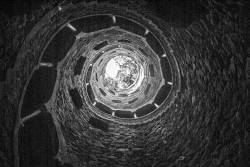Quinta da Regaleira
Useful Information
| Location: | EWest of the historic center of Sintra. Signposted. |
| Open: |
APR to SEP 9:30-20, last entry 19. OCT to MAR 9:30-18, last entry 17. Closed 24-DEC, 25-DEC, 01-JAN. [2020] |
| Fee: | Gro
Self-guided:
Adults EUR 10, Children (6-17) EUR 5, Children (0-5) free, Seniors (65-79) EUR 5, Seniors (80+) free, Family (2+4) EUR 25. Guided tours: Adults EUR 15, Children (6-17) EUR 8, Children (0-5) free, Seniors (65-79) EUR 8, Seniors (80+) free, Family (2+4) EUR 46. [2020] |
| Classification: |
 Grottoes Grottoes
|
| Light: | n/a |
| Dimension: | |
| Guided tours: | |
| Photography: | allowed |
| Accessibility: | |
| Bibliography: | |
| Address: |
Quinta da Regaleira, R. Barbosa du Bocage 5, 2710-567 Sintra, Tel: +351-219-106-650.
E-mail: |
| As far as we know this information was accurate when it was published (see years in brackets), but may have changed since then. Please check rates and details directly with the companies in question if you need more recent info. |
|
History
| 1893 | acquired at a public auction by António Augusto Carvalho Monteiro. |
| 1904 | beginning of construction. |
| 1910 | construction completed. |
| 1920 | purchased by Waldemar d’Orey. |
| 1987 | bought by a Japanese business for private functions. |
| 1995 | inscribed on the UNESCO World Heritage List. |
| 1997 | reclaimed by Sintra local government. |
| 1998 | opened to the public. |
Description

The Quinta da Regaleira was built in the first decade of the 20th century. The property, known as Quinta da Torre, changed hands various times between 17th and 19th century. In 1840, it was bought by the Viscondessa da Regaleira. She transformed it into an elegant summer retreat with a palatial house and chapel and renamed it Quinta da Regaleira.
It was acquired by António Augusto Carvalho Monteiro (*1848-✝1920) at a public auction in 1893. Subsequently, he bought surrounding plots of land giving it the pentagonal outline the property has today. Then he started to rebuild the house and the garden in the ’revivalist’ Neo-Manueline architecture of the times. He hired the Italian scenographer-architect Luigi Manini (*1848-✝1936) who designed the Palacio do Buçaco before. And he employed a small army of sculptors, stonemasons, and craftsmen for six years. Money was no problem, Monteiro had amassed a fortune in Brazil. He was so rich, he was called Monteiro dos Milhões (Moneybags Monteiro). The palace is also known as "The Palace of Monteiro the Millionaire".
The house and the garden are a strange mix of neo-classical and romantic elements. However, this website is about underground tourist sites, and this house applies because of its underground tunnels and grottoes. The Poço Iniciático (Initiation Well) is a subterranean tower sinking 27 m into the earth accessible by a monumental stairway, full of masonic, esoteric and alchemical symbols. Actually there are two of them, and neither was ever used as a well. The second well is called the Unfinished Well. The wells are both entrances to the Underground Walkways, a large network of tunnels linking many buildings of the estate. The tunnels sometimes look like mine tunnels, but other portions look like artificial caves, with concrete speleothems. There is a water-filled entrance at the lake, and the Guardians’ Entrance. Other grottos Leda’s Cave, named after the sculpture of leda and the swan, the Labyrinthic Grotto, and the Grotto of the Virgin.
- See also
 Subterranean World Heritage List
Subterranean World Heritage List Search DuckDuckGo for "Quinta da Regaleira"
Search DuckDuckGo for "Quinta da Regaleira" Google Earth Placemark
Google Earth Placemark Quinta da Regaleira (visited: 23-MAR-2020)
Quinta da Regaleira (visited: 23-MAR-2020) Quinta da Regaleira, official website (visited: 23-MAR-2020)
Quinta da Regaleira, official website (visited: 23-MAR-2020) Cultural Landscape of Sintra (visited: 26-APR-2020)
Cultural Landscape of Sintra (visited: 26-APR-2020) Quinta da Regaleira - Atlas Obscura (visited: 23-MAR-2020)
Quinta da Regaleira - Atlas Obscura (visited: 23-MAR-2020) Quinta da Regaleira, Sintra (visited: 23-MAR-2020)
Quinta da Regaleira, Sintra (visited: 23-MAR-2020) Quinta da Regaleira (visited: 23-MAR-2020)
Quinta da Regaleira (visited: 23-MAR-2020)
 Index
Index Topics
Topics Hierarchical
Hierarchical Countries
Countries Maps
Maps